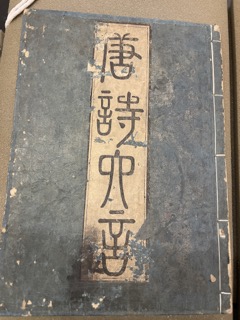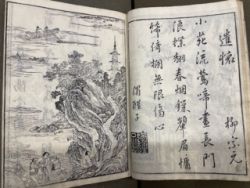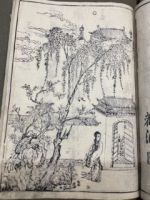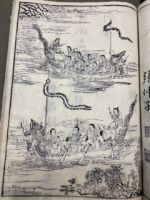The Illustrated Tang Poems

The book Illustrated Tang Poems (Tang Shi Hua Pu) is a collection of paintings and illustrations for poems written during the Tang Dynasty (around the 8th century). Published in 1620 (Ming Dynasty), this book is one of the older books in the Kislak Center for Special Collection at Penn printed with woodblock printing. The poems are from a selection of famous poets in the Tang Dynasty. This set of books is speculated to be one of the first curations of Tang Dynasty poems. These curations became crucial for researchers to collect and curate poetry from the Tang Dynasty.[1]
Historial Significance
By looking at how detailed and well-crafted the illustrations in the book are, we can infer that woodblock printing became relatively mature in China around the 17th century. Since this is a collection of illustrations for poems, we could also infer that perhaps sharing, reading, and appreciating poems was a rather significant part of people’s lives in the Ming Dynasty, Literature and arts were well-celebrated by the society.
The printing shop practices during the Ming Dynasty era were quite intriguing. In the Ming Dynasty, some printing shops would not even verify if they have the most authentic version of the original book to be printed. They would choose whichever edition was readily available for them to publish. As a result, there could be circulation of wrong editions of books.[2] However, this was the main factor for the massive supply of printed books in society during the Ming Dynasty. The term "Bibliophilia" - the passionate love for books - was coined in the Ming Dynasty, as books became available to people of different social statuses due to influential printing shops.
Substrates

There are many interesting features of the book where the substrate of this book plays a significant role in establishing the reading experience for this book.
Printing, Paper & Cover
The book was printed with woodblock printing, and the paper used as the leaves are “xuan paper”. The cover of the book is a stronger type of paper dyed dark blue backed by another xuan paper, which gave it more strength. The xuan paper has a soft texture and is semi-transparent. This gives the readers a unique experience of being able to see through the illustrations to look at the poems as the two are printed on the same sheet.
Binding
The book was bound with the “butterfly binding” method. Two pages are printed on the same sheet, which is then folded inwards. These sheets of paper are then bound to form a book. In particular, for this book, we have one page of the illustration and one page of the poem printed on the same sheet. Since these are folded, readers have to flip to look at the poem for each illustration.
This is an interesting tradeoff made at the substrate level – by prioritizing the ease of printing, the readers cannot enjoy looking at the illustration and reading the poem simultaneously. However, this also allows the readers to see through the illustrations behind each page while reading the poems. This unique reading experience is challenging to reproduce with other types of paper.
As illustrated in the photo. The poem on the right-hand side is about flowers blossoming in the spring, while the illustration at the left is for the following poem, which touches on the meditative aspect of hiking.

Fore-edge
Since each sheet is folded inwards for binding, it gives the book a unique space on the outer edge for each leaf. This became an extra space for printing that is otherwise impossible in other forms of binding. For this book, the fore-edge spaces are used for prologue labeling. For example, it says “Prologue 1” in the picture on the right.
This technique was rather popular in the Ming Dynasty. Printing shops would utilize this space to label different sections of the books, such as prologue and epilogue.[3]


Content
The poems curated in the book touch on a variety of topics. Since each poem comes with an illustration, it is observed that there is a bias of topics toward nature and festivals -- occasions where illustrations can really bring the poem to life. Chinese festivals such as the Dragon Boat Festival, Qingming Festival, Mid Autumn Festival, and Chinese New Year are described in some poems and their illustrations. Other activities such as hiking, tea making, and stargazing are mentioned in other poems.
The most interesting poems are those that portray the cultures of art and poem writing. It is inferred that since the poems are selected alongside their illustrations, the curator is trying to portray the society back in the Tang Dynasty through this anthology.
The poem selection of the books is from many famous poets, including Li Bai, Liu Zong Yuan, Bai Ju Yi, Du Fu. The work of these poets covers many aspects of the Tang society, as well as different eras when the Tang Dynasty had been prosperous or declining. This gives the readers, alongside the illustrations, a holistic overview of the Tang Dynasty, which has a significant cultural impact on Chinese history, poetry, and the arts.
Speculation
It is speculated that this book is part of the collections of Illustrated Tang Poems, as Penn Kislak also owns a couple of other ones. The book does not have a specified author -- the poems could be selected by the printing shop and assembled into books for circulation purposes.
The book is intended for a general audience of the society, as artists and poets flourished during the era. Moreover, the Ming Dynasty established commercial and cultural connections with Japan and Korea, which facilitated the spread of printing technologies and methods around the area.[4]
Reference
- ↑ Owen, Stephen. The Late Tang, (Leiden, The Netherlands: Harvard University Asia Center, 17 Mar. 2020) doi: https://doi-org.proxy.library.upenn.edu/10.1163/9781684174317
- ↑ He, Yuming. Home and the World: Editing the Glorious Ming in Woodblock-Printed Books of the Sixteenth and Seventeenth Centuries. 1st ed. Vol. 82. Harvard University Asia Center, 2013. https://doi.org/10.2307/j.ctt1dnn9bq.
- ↑ Burns, William E., ed. 2020. Science and Technology in World History. N.p.: ABC-CLIO, LLC.
- ↑ Lewis, Mark Edward. China’s Cosmopolitan Empire: The Tang Dynasty. Cambridge, MA and London, England: Harvard University Press, 2021. https://doi-org.proxy.library.upenn.edu/10.4159/9780674054196